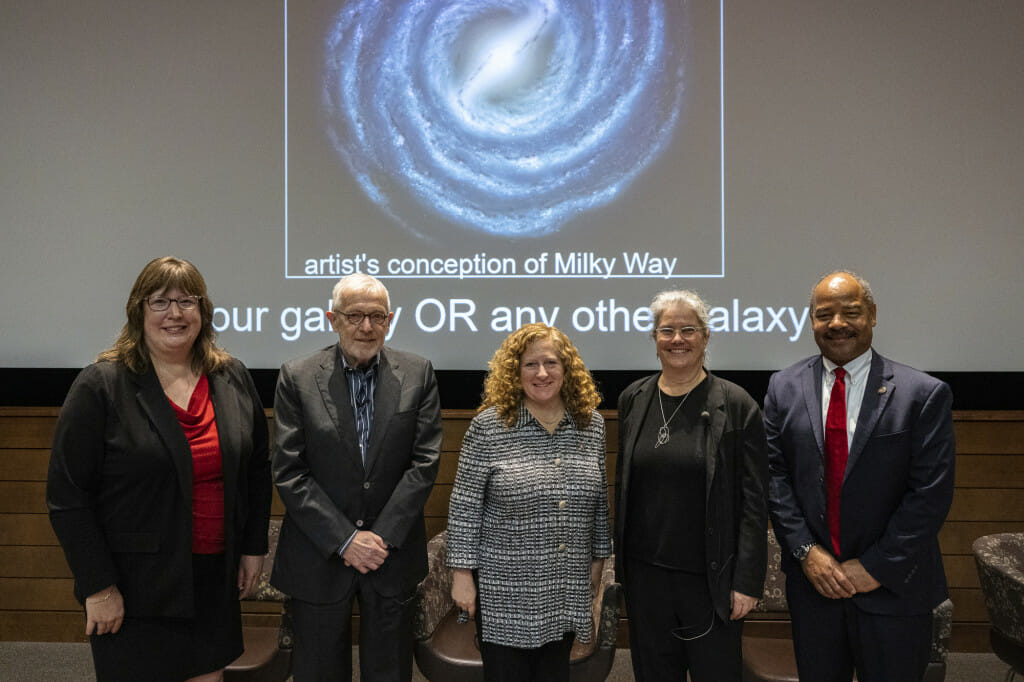
This story was originally published by University Communications as part of their coverage of Chancellor Mnookin’s Investiture
A group of astronomers and physicists, including Physics professor Francis Halzen, shared the stories behind their groundbreaking discoveries and lofty goals before a packed house gathered at University of Wisconsin–Madison’s Marquee Theater on Thursday to celebrate the Investiture of Chancellor Jennifer Mnookin.
The scientists included UW–Madison professors Francis Halzen and Susanna Widicus Weaver, as well as Andrea Ghez, a professor at the University of California, Los Angeles and good friend of Chancellor Mnookin. The symposium was titled “Discovery Past, Present, and Future: Black Holes, Neutrinos, and Life in our Galaxy.”
The friendship between Mnookin and Ghez goes back more than 15 years and is filled with fond memories, among them a champagne toast they shared in Ghez’s backyard to mark her winning the 2020 Nobel Prize in Physics. An attorney with a skill for interpreting legalese, Mnookin ensured the celebratory moment would conform with California’s emergency public health rules during the first winter of the COVID-19 pandemic.
“One of the things I love about Chancellor Mnookin is she is a problem solver,” said Ghez, who shared the 2020 prize for the discovery of a supermassive black hole at the center of the Milky Way galaxy.
Ghez recounted the scientific principles, theories and observations that led to the discovery in a talk that reveled in the surprise of the scientific process — a process that is increasingly enabled by new technologies.
“What’s so fun about what I call ‘technology-enabled discovery’ is that almost everything we’ve been able to look at in the center of the galaxy and its environment is inconsistent with the predictions,” Ghez said. “I like to call that either job security or being a kid in a candy shop.”
The rise of new technologies to help answer fundamental questions about the universe was a common theme among the three panelists, who were introduced by Dean Eric Wilcots of the College of Letters & Science and an astronomer himself.
Halzen described the massive telescope built deep within the ice at UW’s IceCube Neutrino Observatory at the South Pole that has enabled the detection of neutrinos, along with plans for an ice-encased observatory 10 times its size. The ghostly particles zip across the universe unimpeded from high-energy sources like the supermassive black holes now believed to be at the center of virtually all large galaxies.
And Widicus Weaver recounted her work hunting for the chemical signatures that might help identify habitable exoplanets — research that has received a massive boost from the James Webb Space Telescope, which began its science mission less than a year ago.
The discussion began with a history lesson provided by Wilcots, who shared the story of Karl Jansky.
A 1927 graduate of UW–Madison who was known at the time as “the fastest skater on the Wisconsin hockey team,” Jansky went on to work for Bell Laboratories. There he sought to understand the sources of static and radio interference — work that eventually led Jansky to observe a major source of radio interference emanating from the constellation of Sagittarius. Decades later, Ghez discovered the likely source — the supermassive black hole at the center of the galaxy.
Jansky’s observations “effectively started the field of radio astronomy,” Wilcots said, noting UW–Madison’s prominent and ongoing contributions to the field via scientists like Halzen, Widicus Weaver and their many colleagues.
The contributions are in their own ways manifestations of the Wisconsin Idea, Mnookin said in her opening remarks.
“When we talk about the Wisconsin Idea and our impact beyond the borders of our campus, it is awesome to think that there are people in our midst pushing that line beyond our planet, our solar system and even our galaxy,” she said.